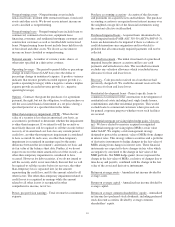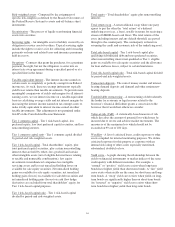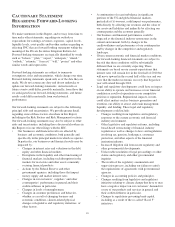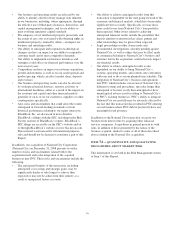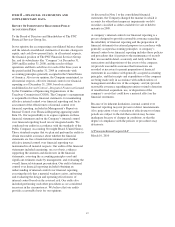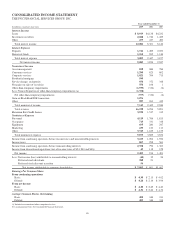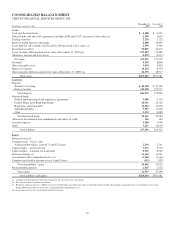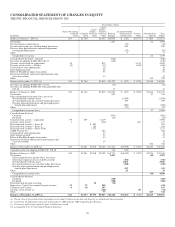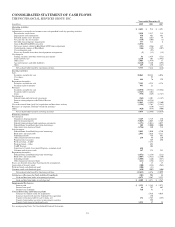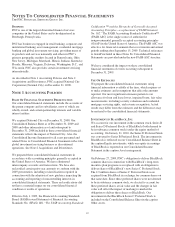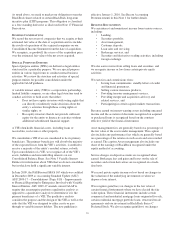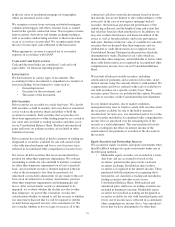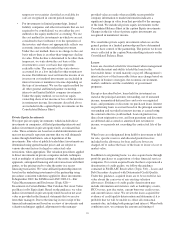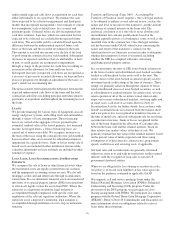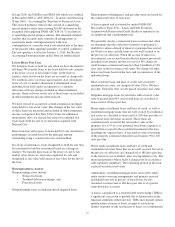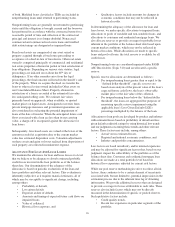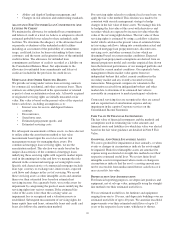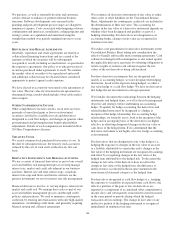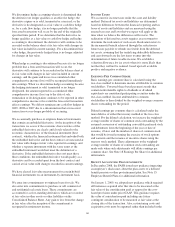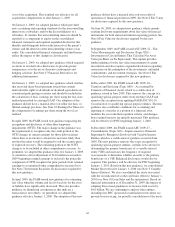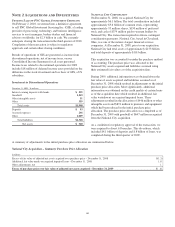PNC Bank 2009 Annual Report Download - page 97
Download and view the complete annual report
Please find page 97 of the 2009 PNC Bank annual report below. You can navigate through the pages in the report by either clicking on the pages listed below, or by using the keyword search tool below to find specific information within the annual report.As noted above, we mark to market our obligation to transfer
BlackRock shares related to certain BlackRock long-term
incentive plan (LTIP) programs. This obligation is classified
as a free standing derivative as disclosed in Note 17 Financial
Derivatives.
B
USINESS
C
OMBINATIONS
We record the net assets of companies that we acquire at their
estimated fair value at the date of acquisition and we include
the results of operations of the acquired companies on our
Consolidated Income Statement from the date of acquisition.
We recognize, as goodwill, the excess of the acquisition price
over the estimated fair value of the net assets acquired.
S
PECIAL
P
URPOSES
E
NTITIES
Special purpose entities (SPEs) are defined as legal entities
structured for a particular purpose. We use special purpose
entities in various legal forms to conduct normal business
activities. We review the structure and activities of special
purpose entities for possible consolidation under the
applicable GAAP guidance.
A variable interest entity (VIE) is a corporation, partnership,
limited liability company, or any other legal structure used to
conduct activities or hold assets that either:
• Does not have equity investors with voting rights that
can directly or indirectly make decisions about the
entity’s activities through those voting rights or
similar rights, or
• Has equity investors that do not provide sufficient
equity for the entity to finance its activities without
additional subordinated financial support.
A VIE often holds financial assets, including loans or
receivables, real estate or other property.
We consolidate a VIE if we are considered to be its primary
beneficiary. The primary beneficiary will absorb the majority
of the expected losses from the VIE’s activities, is entitled to
receive a majority of the entity’s residual returns, or both.
Upon consolidation of a VIE, we recognize all of the VIE’s
assets, liabilities and noncontrolling interests on our
Consolidated Balance Sheet. See Note 3 Variable Interest
Entities for information about VIEs that we do not consolidate
but in which we hold a significant variable interest.
In June 2009, the FASB issued SFAS 167 which was codified
in December 2009 as Accounting Standard Update (ASU)
ASU 2009-17 – Consolidations (Topic 810) – Improvements
to Financial Reporting by Enterprises Involved with Variable
Interest Entities. ASU 2009-17 amends current GAAP to
require that an enterprise perform a qualitative analysis as
opposed to a quantitative analysis to determine if it is the
primary beneficiary of a VIE. The qualitative analysis
considers the purpose and the design of the VIE as well as the
risks that the VIE was designed to either create or pass
through to variable interest holders. The new guideline is
effective January 1, 2010. See Recent Accounting
Pronouncements in this Note 1 for further details.
R
EVENUE
R
ECOGNITION
We earn interest and noninterest income from various sources,
including:
• Lending,
• Securities portfolio,
• Asset management,
• Customer deposits,
• Loan sales and servicing,
• Brokerage services, and
• Securities and derivatives trading activities, including
foreign exchange.
We also earn revenue from selling loans and securities, and
we recognize income or loss from certain private equity
activities.
We earn fees and commissions from:
• Issuing loan commitments, standby letters of credit
and financial guarantees,
• Selling various insurance products,
• Providing treasury management services,
• Providing merger and acquisition advisory and
related services, and
• Participating in certain capital markets transactions.
Revenue earned on interest-earning assets including unearned
income and the accretion of discounts recognized on acquired
or purchased loans is recognized based on the constant
effective yield of the financial instrument.
Asset management fees are generally based on a percentage of
the fair value of the assets under management. This caption
also includes any performance fees which are generally based
on a percentage of the returns on such assets and are recorded
as earned. The caption Asset management also includes our
share of the earnings of BlackRock recognized under the
equity method of accounting.
Service charges on deposit accounts are recognized when
earned. Brokerage fees and gains and losses on the sale of
securities and certain derivatives are recognized on a trade-
date basis.
We record private equity income or loss based on changes in
the valuation of the underlying investments or when we
dispose of our interest.
We recognize gain/(loss) on changes in the fair value of
certain financial instruments where we have elected the fair
value option. These financial instruments include certain
commercial and residential mortgage loans originated for sale,
certain residential mortgage portfolio loans, structured resale
agreements and our investment in BlackRock Series C
Preferred Stock. We also recognize gain/(loss) on changes
93


